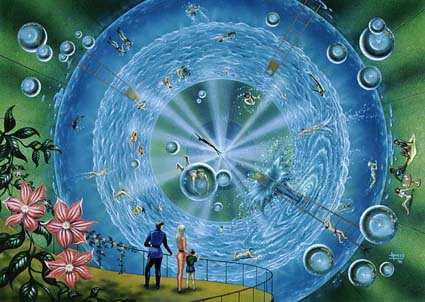 Continued from part 1...
Continued from part 1...
This next group of backers may not qualify for the billionaire category but they have been huge patrons of the private space industry. Jim Benson started the trend of tech entrepreneurs moving into the commercial space market in 1997 with the founding of SpaceDev. SpaceDev provided the unique hybrid rocket motors used on the now famous SpaceShipOne. Benson recently stepped down as CEO/CTO of SpaceDev and announced his intentions of creating a new space venture appropriately named Benson Space Company. Named one of the "50 People to Watch in 2005" by San Diego magazine it is difficult to disagree.
One of the most influential figures has been Anousheh Ansari. Making her fortune through a Telecom company, Anousheh is most famous for helping fund the Ansari X-prize. The $10 million X-prize can be largely accredited for the jump start of the commercial space race. It lead to Burt Rutan's SpaceShipOne, backed by Paul Allen and winner of the X-prive, deal with Richard Branson and the founding of Virgin Galactic.
The prize has also pushed other non-winning companies such as John Carmack's Armadillo Aerospace. Most famous for his co-founding of id Software and for making games such as Doom and Quake, Carmack recently taught himself rocket engineering and is the lead engineer of his company. Armadillo Aerospace has ambitious plans of building orbital spacecrafts.
Elon Musk, another internet mogul other than Jeff Bezos, has also shown some serious interest in space. Using his fortune (estimated at $328 million) earned from his creation of PayPal, Musk founded Space Exploration Technologies (SpaceX). SpaceX currently has one rocket, the Falcon 1, that was launched unsuccessfully this year but is scheduled for a relaunch this month. Elon has said he is willing to fund up to three unsuccessful launches before he decides to scrap the company. With success of upcoming launches there looks to be a lot of promise. SpaceX has already sold 11 contracts for flights on the various Falcon rockets. The company was recently awarded the Indefinite Delivery/Indefinite Quantity (IDIQ) contract for Responsive Small Spacelift (RSS) launch services from the US Air Force that could be worth up to $100 million worth of launches.
 Space Adventures founder Eric Anderson has taken unique steps to gleaning his wealth and power in the commercial space industry. He is unique because he has been the only one to start his entrepreneurial ventures in the actual private space industry and his company has thus far been the only company in the world to have sent private citizens to space. Joining several visionaries in the aerospace industry, Anderson's company has sold more than $120M in space tourist flights.
Space Adventures founder Eric Anderson has taken unique steps to gleaning his wealth and power in the commercial space industry. He is unique because he has been the only one to start his entrepreneurial ventures in the actual private space industry and his company has thus far been the only company in the world to have sent private citizens to space. Joining several visionaries in the aerospace industry, Anderson's company has sold more than $120M in space tourist flights.
He has also currently developed and financed over $500 million in new projects, including a deal with the Ansari family's company, Prodea, and the Russian space agency (FSA) to develop a suborbital space transportation system called Explorer, a project for two global spaceports and another one for the first private voyage to the moon, set to launch in 2009. The Explorer will be able to transport up to five people to space and is designed to maximize the customer's experience of space travel. The two commercial spaceports have been announced for development in the United Arab Emirates and in Singapore. Most exciting, however, is the project for the first private voyage to the moon. The project is titled the Deep Space Expedition Alpha (DSE-Alpha) and has plans for sending tourists on a trip around the moon. Space Adventures has partnered with the FSA to use modified Soyuz capsules for the trip. Seats for the trip come at a hefty price though. Two commercial seats are available for an incredible $100 million. But, with another customer of theirs, Dennis Tito, paying $20 million for a trip to the ISS, a $100 million ticket price for a trip around the dark side of the moon might be the right price for a wealthy enthusiast.
The last figure in my series of money backers is Robert Bigelow. Bigelow is at the forefront of the private space industry and looks so promising that all the information about him cannot fit in this article alone. Continue coming back and looking for an updated article exclusively about his contributions to commercial space, including a deal for a launch with Elon Musk and SpaceX.
And... as always, feel free to comment on or ask about anything you please! I feed off of your input and always look forward to it. Thanks for everyone's contributions so far!
Related Articles:











